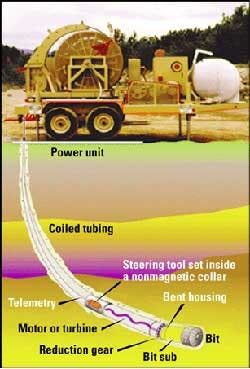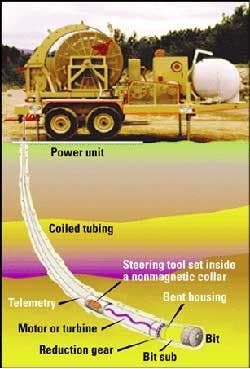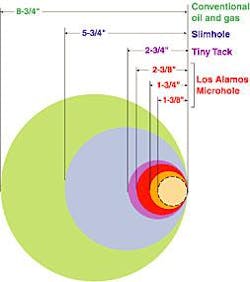Applied technology projects sponsored by government, academia, and industry offer improved tools and techniques for drilling. Collaborative projects have been successful, and integrating emerging technologies with accepted tools offers unique value.
New research initiatives and collaborations will create additional tools and useful pairings of accepted technologies.
Smart oil fields
ChevronTexaco Corp. is funding the Center of Interactive Smart Oilfield Technologies (CiSoft) at the University of Southern California (USC), the company announced in August 2003. Faculty and other resources will come from the USC School of Engineering's Information Sciences Institute, the Integrated Media System Center, and the Petroleum Engineering Program.
ChevronTexaco plans to provide drilling and production data from around the world that will contribute to the research and development of integrated technologies facilitating operations in instrumented, intelligent oil and gas fields.
C.L. Max Nikias, dean of the USC School of Engineering, said, "Through this partnership, ChevronTexaco and USC hope to create an exceptional learning environment for engineering students while accelerating the development of advanced oil field technologies." The engineering school will create a new MS degree program integrating information technology and petroleum engineering.
null
Don Paul, vice-president and chief technology officer at ChevronTexaco, said that the "USC School of Engineering is recognized for leadership and innovation in many areas, but has earned particular distinction for its work in information and communications technology, advanced visualization and petroleum engineering."
Research in new and emerging well technologies is an integral part of ChevronTexaco's "i-field" program, and Paul expects that CiSoft will be "a unique environment for developing new technologies for real-time engineering and operations."
Chevron's i-field program is a major technology initiative dealing with instrumented fields, real-time information, intelligent decisions and integrated solutions, including new and emerging well technologies.
Carbon fiber drill pipe
The US Department of Energy's National Energy Technology Laboratory (NETL) announced last month that a new type of lightweight drill pipe made of carbon fiber composites had been successfully tested in a horizontal gas well in Leflore County, Oklahoma.
The pipe is made of graphite fibers wound around a spindle with epoxy resin. After the pipe cures and the supporting spindle is removed, the pipe is machined and then coated to resist abrasion.
It was developed by Advanced Composite Products and Technology, Huntington Beach, Calif., under a $2.82 million, 5-year contract with the Energy Department's Office of Fossil Energy.
Gary Covatch of NETL's Gas Technology Management division said, "It could revolutionize the drilling industry because of its versatility and strength.
"The composite pipe is more flexible than steel drill pipe. This flexibility is an especially important advantage in permitting producers to reenter old wells and drill horizontally to reach untapped natural gas formations. It could provide an important new tool for the industry to recover more gas, keep recovery costs low, and extend the life of many of the nation's gas wells," said Covatch.
Carbon fiber pipe was tested in November 2002 and January 2003 using rotary drilling tools for short-radius (radius of curvature less than 60 ft) reentry drilling (OGJ, Feb. 24, 2003, p. 63). However, this latest field test used air-hammer drilling to drill a hard, abrasive formation at 1,385 ft with 21/2 in. pipe.
The air hammer tested the fatigue life and mechanical strength of the pipe, but after a week of drilling, the pipe showed few or no signs of wear. Additional tests are planned. The proved durability of carbon fiber pipe in an abrasive formation is especially significant because it had been previously thought that only titanium pipe was sufficiently flexible and durable, and carbon fiber pipe may now provide another option for drilling abrasive formations.1
Composite carbon fiber pipe currently costs about three times more than steel drill pipe, but it does not appear to fracture or wear as rapidly as steel when bent continually in horizontal drilling, according to DOE's announcement.
Next-generation developments include imbedding a wire in 7-in. composite pipe to transmit real-time data and enable "smart" drilling systems.
Casing drilling
Drilling directly with casing reduces drilling time by reducing trips and saves the cost of casing, its transportation, and storage. The casing drilling process is patented by Tesco Corp., and the process was commercialized by ConocoPhillips and Tesco in a multi-year, multi-well contract (OGJ, Mar. 18, 2002, p. 64-5).
Rigs built specifically for casing drilling are smaller and more efficiently designed and require less mobilization time. They can be expected to have an increased hook-load rating, a reduced footprint, and an automated or semi-automated casing handling system.
Smaller casing drilling rigs have a distinct advantage in a situation where a helicopter is required to transport a rig and conventional drillstring into a remote area.
null
ConocoPhillips' casing drilling program in the Lobo field, South Texas, utilized a dual-purpose rig (conventional and casing drilling) to drill the first 22 wells. The company expanded the drilling program and added three new Tesco "Genesis Series" casing drilling rigs in first-quarter 2003. ConocoPhillips chose casing drilling with a retrievable bottomhole assembly (BHA) in order to overcome repeated instances of stuck pipe and lost circulation.
A related approach is drilling with production tubing, rather than casing. In July, Petróleos Mexicanos (Pemex) and Tenaris SA announced that they had drilled a 3,265-ft interval, from 5,168 to 8,433 ft in the Pandura 501 well using 31/2-in. Tenaris PJD production tubing.
A drilling with casing (DwC) process is also offered by Weatherford International Ltd., which has been successful offshore. A casing string was drilled down from a floating drilling unit in November 2002 by Weatherford (OGJ, Apr. 21, 2003, p. 47).
Directional casing drilling was successful in two offshore wells in the Gulf of Mexico to 3,332 ft and 3,838 ft, using prototype tools for Tesco's casing drilling system.
In the future, we can expect new developments to enable high-angle directional casing drilling, casing drilling in deep water, casing drilling while air drilling, and ultimately, casing drilling with expandable tubulars.
Through-tubing rotary drilling
Through-tubing rotary drilling (TTRD) involves slimhole sidetracks drilled through the production tubing of an older well. Because the old tubing doesn't have to be pulled out of the ground (requiring the use of a rig), the operator saves time and money.
With TTRD, drillers can rotate pipe inside the completion tubing, reducing the friction from sliding and potential hang ups. It's generally utilized in 41/8 to 5 in. holes.
It is necessary to assess the condition of the tubing with a caliper survey before TTRD operations to make sure the walls are sufficiently thick to sustain the wear of the subsequent drilling operations.
A drawback of TTRD is the limitation on the size of wireline or LWD logging tools. Service companies have developed suites of slimhole logging tools, among them AnTech Ltd., Baker Hughes INTEQ's slimhole (43/4 in.) density neutron and ultraslim (31/8 in.) multiple propagation resistivity, CBG Corp.'s slimhole (1.05 in.) MWD and steering, Century Geophysical Corp., PetroAlliance Services Co. Ltd., Robertson Geologging Ltd., Scientific Drilling, and Schlumberger's SlimAccess and SlimXtreme logging suites.
ARCO-BP's Shared Services Drilling group completed four wells using TTRD on Alaska's North Slope, and Shell Expro drilled four TTRD wells from the North Cormorant platform in the North Sea.
BP PLC drilled two TTRD wells, A13 and A22, from the Bruce platform in the North Sea earlier this year, following success with TTRD in the Forties field and the Magnus field. BP saw significant cost savings over conventional side-tracks in not having to pull the christmas tree or the original completion. The company successfully ran Baker Oil Tools' new 51/2-in. through-tubing retrievable whipstock in the Bruce A22, in order to maintain production from the mother bore.
Rotary steerable drilling
Schlumberger Ltd. announced in September development of a new rotary steerable system for slimhole drilling and TTRD applications at its Global Drilling Technology Center in Stonehouse, Gloucestershire, UK, under contract to Shell UK Ltd. and BP Exploration Operating Co.
The system is scheduled to be completed in 2005.
Todd Franks, a well engineer on Shell's E&P technology team, said, "With the push to maximize production from mature reservoirs where the drilling targets are becoming smaller and smaller, we had to find a way of reducing drilling costs and sidetracking from an existing but obsolete well. Developing a rotary steerable system for drilling slimholes will help us reach targets and achieve drilling performance comparable to conventional hole sizes."
The technology will be especially useful in the maturing North Sea because of the cost discipline necessary to produce smaller recoverable reserves. Ian Searle, senior drilling engineer at BP, said, "The system will play a significant role in unlocking additional recoverable reserves and extending the life of the North Sea oil industry."
An emerging trend is the introduction of simpler, lower cost rotary steerable tools by Rotary Steerable Tools (RST) Inc. (OGJ, June 9, 2003, p. 45).
The Scottish Executive announced last month that Technology Ventures International Ltd., Aberdeen received one of the 17 Smart Scotland awards for "Design and Testing of an Innovative Low Cost Rotary Steerable System for Slim Hole Infill Drilling." The monetary prize is to fund "the development of innovative and commercially viable products and processes."3
Among the more advanced systems is Baker Hughes INTEQ's AutoTrak rotary closed loop drilling system, an integrated drilling and MWD system, used widely by BP. On Sept. 30, the RCLS surpassed 8.5 million ft of hole drilled worldwide. The system is available in three sizes (63/4 in., 81/4 in., and the new 91/2 in.) to cover hole size ranges from 83/8 in. to 181/4 in. hole.
Sperry-Sun's Geo-Pilot 7600 series rotary steerable system was developed in collaboration with the Japanese National Oil Corp. (JNOC). It successfully drilled an 11,068-ft high-angle, extended reach 81/2-in. well for ConocoPhillips' Alpine project on Alaska's North Slope in a single run, with 164 fph average rate of penetration.
null
Coiled-tubing advances
Drilling and completing of wells with coiled-tubing units instead of drilling rigs can be a cost-effective strategy, particularly with sidetracks. A slim BHA with a drilling motor, rather than a rotary table, provides rotation to the bit, and a special injector system is used to run in the hole. Each year, 900 to 1,000 coiled-tubing wells are completed.2
DOE awarded a $5-million contract to Maurer Technology Inc., a Noble Corp. subsidiary, to develop an economical coiled tubing, high-pressure, jet drilling system. Maurer has developed and lab-tested downhole motors that drill two to three times faster than traditional CT motors. They will be field-tested and commercialized in the next phase of the DOE project.
Extended-reach wells
Wells drilled with a high degree of precision to reach small or multiple targets or to navigate through or around faults to isolated traps have been variously termed "extended-reach," "designer," "snake," or "connector" wells.
Tight turns are easier with open hole drilling, as tight as 100° in 100 ft, but drilling with liner or casing is more problematic. Rotary steerable systems are useful in extended reach wells where wellbore friction severely limits the steerability of mud motors.
K&M Technology Group's ERDesigner software well construction system includes well design, feasibility, and cost criteria, and handles deviated, extended reach, horizontal, and deepwater wells (OGJ, Apr. 28, 2003, p. 66).
Microhole drilling
NETL has recently undertaken a $6-million project, dubbed the "Microhole Technology Initiative," working with wellbore diameters 23/8 to 13/4 in. (Fig. 2).
The program performance goal, according to NETL, is that by 2009, the project will "determine the viability of microhole technology as a lower-cost technology that can benefit domestic oil and gas exploration and production, including the development of miniaturized sensors and other downhole drilling components."4
The drilling engineering projects include drilling shallow microholes using currently available coiled tubing technology, evaluating the feasibility of drilling deep microholes, and the miniaturization and testing of bottomhole drilling assemblies.
A specific target is the development of a low-cost, high performance microhole system capable of drilling to 5,000 ft.
The new DOE project is based on earlier exploratory research conducted by the Los Alamos National Laboratory, which included development of a highly automated micro drilling rig and three successful field demonstrations involving 13/4 and 23/8 in. diameter holes drilled to 700 ft (Fig. 1).
Los Alamos researchers were aided in the early stages of the project by Texaco, Phillips Petroleum, and members of DeepLook Collaboration (five producers and six service companies) who provided technical advice on coiled-tubing drilling.
Jim Albright and Don Dreesen, Los Alamos National Laboratory, discussed the potential for drilling deep microholes with coiled tubing equipment in a two-part series (OGJ, Jan. 10, 2000, p. 39 and Jan. 17, 2000, p. 56).
Potential commercial applications for microholes are shallow development wells, such as infield drilling; reservoir data monitoring holes; shallow reentry wells (deepening and multilaterals); and deep exploration holes.
Companies can expect cost savings from the reduced volume of all drilling materials used in microdrilling. Drilling fluids could be as little as 1/40, as microdrilling only about a barrel of fluid per 1,000 ft drilled, whereas conventional drilling requires fluid at about 40 bbl/1,000 ft.5
References
1. Smith, J., et al., "Titanium drill pipe a viable option for short-radius horizontal drilling," Drilling Contractor, pp. 34-35, January-February 2000.
2. Donald, D., "Through tubing rotary drilling versus coiled tubing drilling— the pros and cons," presentation at SPE Aberdeen section meeting, http:// www.imajica.co.uk/spepres/TTRD050203.pdf, Feb. 6, 2003.
3. "Smart Scotland awards," www.- scotland.gov.uk/pages/news/2003/10/SEEL114.aspx, Oct. 15, 2003.
4. "Microhole Systems," www.fossil.energy.gov/programs/oilgas/microhole/
5. "Microdrilling Technology Advances in Los Alamos Field Test," DOE Fossil Energy TechLine, www.netl.doe.- gov/publications/press/1999/tl_microdril1.html, Oct. 20, 1999.



